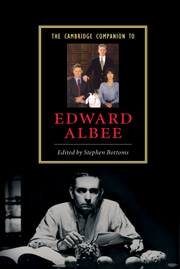Book contents
- Frontmatter
- 1 Introduction
- 2 Albee’s early one-act plays
- 3 Who’s Afraid of Virginia Woolf?
- 4 “Withered age and stale custom”
- 5 Albee’s 3½
- 6 Albee’s threnodies
- 7 Minding the play
- 8 Albee’s monster children
- 9 “Better alert than numb”
- 10 Albee stages Marriage Play
- 11 “Playing the cloud circuit”
- 12 Albee’s The Goat
- 13 “Words; words... They’re such a pleasure.” (An Afterword)
- 14 Borrowed time
- Notes on further reading
- Select bibliography
- Index
- Series List
1 - Introduction
Published online by Cambridge University Press: 28 May 2006
- Frontmatter
- 1 Introduction
- 2 Albee’s early one-act plays
- 3 Who’s Afraid of Virginia Woolf?
- 4 “Withered age and stale custom”
- 5 Albee’s 3½
- 6 Albee’s threnodies
- 7 Minding the play
- 8 Albee’s monster children
- 9 “Better alert than numb”
- 10 Albee stages Marriage Play
- 11 “Playing the cloud circuit”
- 12 Albee’s The Goat
- 13 “Words; words... They’re such a pleasure.” (An Afterword)
- 14 Borrowed time
- Notes on further reading
- Select bibliography
- Index
- Series List
Summary
It is now more than forty years since Edward Albee's Who's Afraid of Virginia Woolf? - the play for which he is still best known - gave him his first Broadway hit and propelled him into the front rank of American playwrights. Today, he is frequently listed alongside Eugene O'Neill, Tennessee Williams, and Arthur Miller as one of the nation's great (white, male) dramatists of the twentieth century. Other candidates for that shortlist have appeared since (David Mamet, perhaps Sam Shepard, Tony Kushner), but these writers, operating primarily in the decentered, post-1960s world of off-Broadway and regional theatre, have never been Broadway mainstays in the way their predecessors were. Thus Albee, who hit Broadway just before Broadway's preeminence as a launching pad for serious drama began seriously to be questioned, has for many years tended to be seen as “the last of the line,” and, consequently, as a figure not only of the establishment, but also of the past. In a fragmented, postmodern theatre culture full of young pretenders and competing, multicultural voices, it is all too easy to forget that the somewhat patrician figure of Edward Albee was himself once a controversial young iconoclast, and indeed that, throughout his long career, he has consistently refused to do what is expected of him - and has the sling and arrow scars to prove it.
- Type
- Chapter
- Information
- The Cambridge Companion to Edward Albee , pp. 1 - 15Publisher: Cambridge University PressPrint publication year: 2005

